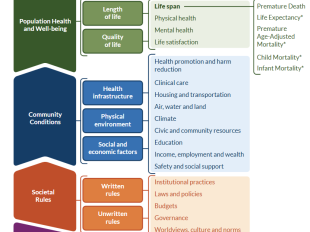Innovative Findings From Our 2019 Research Grantees
In 2019, County Health Rankings & Roadmaps (CHR&R) supported research to advance methods and measurement for community health improvement and equity, and to increase the beneficial impact of Rankings’ data in communities. Three projects—from Drexel University, the University of California-Los Angeles (UCLA) and Rutgers University—were selected for funding, all sharing a common focus: refinement of the current County Health Rankings’ methodology, as well as exploration of novel data sources and health metrics. Despite the challenges from the ongoing COVID-19 pandemic this past year, we are happy to share some of the findings from these innovative lines of research.
Drexel University, Philadelphia, PA – Statistical modeling can help improve the quality of data for measures where there is not much data available, whether due to rare events or small populations. Led by Dr. Harrison Quick, the Drexel team of grantees sought to explore the utility of spatial Bayesian models to improve the precision of small area estimates used by the County Health Rankings. The results of their work are not only an important contribution to the field of spatial epidemiology, they also lay the foundation for the use of modeled estimates in the Rankings, which uses modeled estimates for measures like premature death. Currently, their team has two manuscripts under review for publication, at Spatial and Spatio-Temporal Epidemiology and Statistics in Medicine.
UCLA, Los Angeles, California– To be able to address health inequities in U.S. communities, you first need an accurate picture of the size and scale of the disparities by race/ethnicity and class that exist in key health metrics. Dr. Frederick Zimmerman and the team at the UCLA Fielding School of Public Health are leaders in the field of health disparities measurement. Their Health Equity Metric (HEM) was informed by the Robert Wood Johnson Foundation’s definition of health equity, pioneered by Paula Bravemen. Bravemen’s conceptualization of equity implies that the health of the most advantaged members of a community serves as a marker of a minimum level of health that should be attainable by all residents. The HEM uses this concept in comparing the health of individuals in a community to the experience of a socially advantaged category: highly educated white men. Using Rankings data, UCLA was then able to calculate the HEM for 400 of the nation’s largest counties. In the future, communities could use the HEM to find areas of disparity for increased investment.
Rutgers University, Camden, New Jersey - The Rankings, by design, compare counties to their peers within states. For comparisons across states, visitors to the CHR&R website can use our peer counties tool to compare their county, side-by-side, with any county of their choice, or select from a list of suggested peer counties that were assembled in collaboration with the Centers for Disease Control. The team at Rutgers explored a new angle: by using statistical modeling to determine where a county’s health outcomes fall relative to their peers, they were able to quantify how well a county is expected to perform given its social and economic circumstances. This research can be helpful in deciding where to allocate community resources by identifying areas in which a county may be either overperforming or underperforming relative to what is expected.
We are excited to continue learning and collaborating with innovators in the field. Information on our past research grant projects, as well as calls for future grant proposals in Spring 2021, can be found here.



